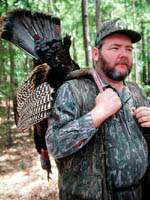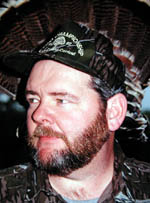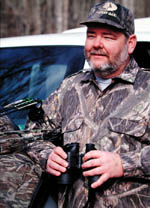
|
Features
|
|
|
|
Books
|
|
|
|
Fun & Games
|
|
|
|
Contact Us
|
|
|
John's Journal... Entry 192, Day 4
TIPS FROM DIXIE'S TOP TURKEY HUNTERS
Ronnie Strickland
 EDITOR'S
NOTE: If you hunt turkeys in the South, you have
to deal with several subspecies of birds under different hunting conditions
and a wide variety of terrain. In ...
EDITOR'S
NOTE: If you hunt turkeys in the South, you have
to deal with several subspecies of birds under different hunting conditions
and a wide variety of terrain. In ...
* Florida, you'll hunt palmetto swamps and pastures,
* Virginia, you'll hunt the mountains and the valleys,
* Texas, you'll hunt arid desert lands,
* Mississippi and Louisiana, you'll hunt along flood plains,
* Alabama, you may hunt pine plantations,
* many sections of the country, you'll hunt crop lands and
* other regions you'll hunt in deep woods. To have success hunting turkeys
in the South, you must use many tactics and understand the differences
in the turkeys and the terrain you hunt. I've interviewed some of Dixie's
top turkey hunters to give you situations and strategies that will help
you take more toms this spring.
GET YOUR FEET WET HUNTING SWAMPS WITH RONNIE STRICKLAND OF WEST POINT, MISSISSIPPI, VICE PRESIDENT OF HAAS OUTDOORS, THE MAKERS OF MOSSY OAK CAMOUFLAGE:
 Question:
What are some tips you can give hunters who will hunt in swamps and flood
plains this spring for toms?
Question:
What are some tips you can give hunters who will hunt in swamps and flood
plains this spring for toms?
Ronnie Strickland: I was born on the Mississippi River and hunted from
Vicksburg to Woodville all along the flood plain. The terrain in a flood
plain swamp is all the same, and throughout most of the spring, you're
dealing with floodwaters either coming in or going out of your hunting
site. You just assume every day you go turkey hunting that you're going
to get wet -- at least from your knees down or your armpits down. Any
day you don't get wet, consider yourself to have had a great day of turkey
hunting. When the river floods, it cleans the forest floor of all foliage
and leaves, often leaving a high-water mark of cleared ground about 4
feet high. For this reason, the turkey can see you from a long way off.
In many places, you may be able to see from 100 to 300 yards. However,
just remember that the turkey can see you just as far away as you can
see him. You need to wear camouflage to be successful. Besides wearing
full camo from head to toe, I usually always build some type of little
blind in front of me and make sure I have a bush or a tree bigger than
my shoulders behind me to break up my silhouette. You also must wear mosquito
repellant to keep the mosquitoes from biting your hide and also prevent
you from having to swat them. When you're calling a swamp gobbler, call
only half as often and half as loud as you usually will. A swamp gobbler
knows exactly where the sound is coming from when he hears you. And if
he doesn't see a hen where that sound has been coming from, many times
he'll be spooked.
 In
states that permit the use of a decoy, I strongly recommend the use of
a decoy when you're hunting in the swamp. I also always take a pair of
compact binoculars with me. I want to see the turkey as far away from
me as I can and then hopefully he won't see me. Learn the high points
where swamp turkeys usually go to feed, strut and breed. A high point
only may be a piece of ground that's a foot or two above water. Also remember
that swamp turkeys don't mind wading water up to their knees to come to
you. Because these turkeys live in water, water won't hang them up nearly
as bad as a stream in big woods will hang up a gobbler there.
In
states that permit the use of a decoy, I strongly recommend the use of
a decoy when you're hunting in the swamp. I also always take a pair of
compact binoculars with me. I want to see the turkey as far away from
me as I can and then hopefully he won't see me. Learn the high points
where swamp turkeys usually go to feed, strut and breed. A high point
only may be a piece of ground that's a foot or two above water. Also remember
that swamp turkeys don't mind wading water up to their knees to come to
you. Because these turkeys live in water, water won't hang them up nearly
as bad as a stream in big woods will hang up a gobbler there.
To learn more about John E. Phillips' turkey-hunting books, click here.
TOMORROW: JIM CRUMLEY AND PRESTON PITTMAN
Check back each day this week for more about TIPS FROM DIXIE'S TOP TURKEY HUNTERS ...
Day 1 - Successful Turkey
Tactics with Eddie Salter
Day 2 - Cecil Carder and Allen Jenkins
Day 3 - Brad Harris, David Hale and Jim Clay
Day 4 - Ronnie Strickland
Day 5 - Jim Crumley and Preston Pittman